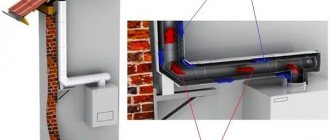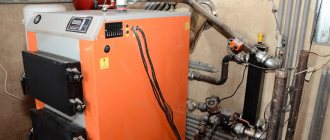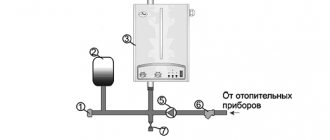Distinctive features
The purpose of the geyser is to heat water . The characteristics of the device determine how quickly and in what quantity the water can heat up. In order not to make a mistake in choosing a device, you should understand its structure.
The first columns with an open combustion chamber consist of a metal body, a gas burner with an igniter, a heat exchanger, an automatic gas valve with a combustion intensity regulator, a mechanical water unit with a safety valve, an ignition system, a diffuser for connecting the chimney, as well as pipes for supplying water and gas, located at the bottom of the structure.
A device with a closed gas combustion chamber has a similar structure, but has a number of differences:
- the classic burner has been replaced by a stepped or modulating burner, which changes the flame intensity automatically;
- air is forcedly supplied using a fan;
- the flame is ignited automatically through the electrical network or a hydrogenerator;
- after heating, the water temperature is maintained due to the presence of a special sensor connected to the controller.
Dangers arising when using the column as a boiler
Before you decide to create heating using a gas water heater, you need to be prepared for possible emergency situations:
- When there is a power outage, the pump stops and the column may fail. In some cases, this even leads to the device exploding.
- If the gas pressure drops, the valve is unlikely to operate.
- If the water pressure in the system decreases, the device will not be able to turn off due to the lack of an appropriate sensor.
Types and description
The store's assortment consists of a huge number of devices with different technical characteristics.
All models can be divided into two types:
- flow-through;
- cumulative.
Flow-through
The column is not equipped with a storage tank and serves to instantly heat up the liquid . Inside the device there is a heat exchanger with a water tube, and under it there is a gas burner. When fuel is burned, heat is generated, which heats the water and sends it through a heat exchanger.
Spent fuel accumulates in the collector and is discharged to the street.
Simple models are equipped with mechanical controls . In more expensive devices, ignition is performed automatically when the hot water tap is turned on. The water temperature is regulated by a standard gearbox or more modern electronics.
The speakers are equipped with an open combustion chamber . The exhaust gas is discharged through a conventional chimney or through a forced ventilation system. The second option is used in apartment buildings.
The devices are equipped with a security system and are therefore safe to use.
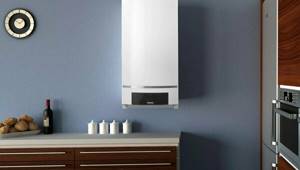
Cumulative
The devices are similar to electric boilers . The only difference is the heat source. The base is a container where hot water is stored. The device is equipped with a heat exchanger, inside which combustion products move.
The combustion process occurs in the lower part of the structure, where the burner is located . Special dividers are provided so that the gas gives off heat when moving upward.
How to convert a column into a heating boiler?
Some owners of an instantaneous water heater want to turn it into a cheap source of heat. After all, a good gas boiler is quite expensive. How to make heating from a gas water heater? To do this, you will have to make some changes to the device:
- turn off the sensor that regulates water pressure;
- connect the circulation pump;
- remove sensors that detect overheating;
- install a hydraulic arrow.
Find out more about how to properly install a geyser in a Khrushchev-era building here
After retrofitting, the gas water heater will be able to operate as a gas boiler. However, the resulting device will have too many disadvantages:
- Disabling the sensors will reduce the safety level of the device.
- You will have to independently control the combustion process. You cannot leave a running speaker unattended for a long time.
- The column pipe for liquid inlet is designed for cold water. When using a water heater as a boiler, heated coolant will flow into the return line, which can lead to failure of the plastic elements on the inlet pipe.
- The column heat exchanger has a small diameter, which will not allow the coolant to move at high speed. Therefore, you will have to buy a circulation pump.
- The efficiency of a water heater is lower than that of a gas boiler of similar power. Therefore, a gas water heater as a heating device will consume too much fuel.
- The column has a sensor that turns off the device when the temperature is exceeded. The average heating rate is 40°C. But this is not enough for full heating. When reaching 60°C, the overheating protection will turn off the column. Then it is necessary to remove the temperature sensors.

Some users want their geyser to produce not only heat, but also hot water. A conventional instantaneous water heater cannot provide two functions at once. However, there are models of columns with built-in storage that are capable of operating both for heating and for the production of domestic hot water. But this option also has significant disadvantages:
- Even when connected to heated floors, there will be a lack of heat.
- Gas consumption will be 1.7-2 times higher than that of a boiler of similar power.
In order for a geyser to heat your home efficiently, you also need to consider the location of the radiators. It is important that when passing through the heating system, the water returns sufficiently cooled - no warmer than 30°C. The water cools faster when the batteries are arranged in series.
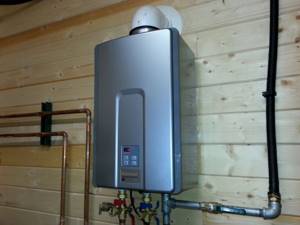
Advantages and disadvantages
Advantages:
- Compactness. Even the unit with the tank does not take up much space, so it can be successfully camouflaged indoors.
- Saving. Heating water with gas is cheaper than heating water with electricity. Heating water in this way costs less than centralized hot water supply.
- Several water intake points. A flow-through gas water heater is sufficient to heat water for three or more points. A device with a power of 8 kW or more, which is connected, is sufficient.
- Low price. The devices are cheaper than devices powered by electricity. The range of brands includes many models at budget prices that are not inferior to more expensive devices.
Flaws:
- Difficult installation. Gas water heaters are more difficult to install than electric water heaters. Besides, you can’t do it without outside help. It is necessary to call specialists and also obtain permission to install the equipment.
- High power. The gas main must have high power, so installing a water heater in many apartment buildings is problematic.
- Removal of combustion products. The waste generated after combustion must be disposed of somewhere. It is necessary to organize a chimney. This is easy to do if a person lives on the top floor. Others will have to build the system from the outer wall of the house or install a turbine column, then make a special hole in the wall.
- Danger. The risk of an emergency should be minimized by installing a column with a protective system. Most modern devices have a security system. It is also necessary to ensure a regular supply of fresh air: 10 units of oxygen per 1 unit of volume of gas burned.
How to convert a column into a heating boiler?
Some owners of an instantaneous water heater want to turn it into a cheap source of heat. After all, a good gas boiler is quite expensive. How to make heating from a gas water heater? To do this, you will have to make some changes to the device:
- turn off the sensor that regulates water pressure;
- connect the circulation pump;
- remove sensors that detect overheating;
- install a hydraulic arrow.
Find out more about how to properly install a geyser in a Khrushchev-era building here
After retrofitting, the gas water heater will be able to operate as a gas boiler. However, the resulting device will have too many disadvantages:
- Disabling the sensors will reduce the safety level of the device.
- You will have to independently control the combustion process. You cannot leave a running speaker unattended for a long time.
- The column pipe for liquid inlet is designed for cold water. When using a water heater as a boiler, heated coolant will flow into the return line, which can lead to failure of the plastic elements on the inlet pipe.
- The column heat exchanger has a small diameter, which will not allow the coolant to move at high speed. Therefore, you will have to buy a circulation pump.
- The efficiency of a water heater is lower than that of a gas boiler of similar power. Therefore, a gas water heater as a heating device will consume too much fuel.
- The column has a sensor that turns off the device when the temperature is exceeded. The average heating rate is 40°C. But this is not enough for full heating. When reaching 60°C, the overheating protection will turn off the column. Then it is necessary to remove the temperature sensors.
Some users want their geyser to produce not only heat, but also hot water. A conventional instantaneous water heater cannot provide two functions at once. However, there are models of columns with built-in storage that are capable of operating both for heating and for the production of domestic hot water. But this option also has significant disadvantages:
- Even when connected to heated floors, there will be a lack of heat.
- Gas consumption will be 1.7-2 times higher than that of a boiler of similar power.
In order for a geyser to heat your home efficiently, you also need to consider the location of the radiators. It is important that when passing through the heating system, the water returns sufficiently cooled - no warmer than 30°C. The water cools faster when the batteries are arranged in series.
How to choose and what to pay attention to - 10 tips from a professional
When choosing a column, you need to pay attention to the number of water intake points that the device will serve, and the volume of hot water, which is calculated based on the needs of the family. There are other parameters that you should also take time to study.
Volume of the tank
The main disadvantage of a boiler is the limitation in the amount of water . When the tank is empty, you need to wait half an hour or more for the required amount of water to heat up.
To reduce this minus to a minimum, you need to calculate the required tank volume. It is necessary to take into account the volume for washing and other needs.
NOTE!
It is worth noting that too large a boiler can lead to unnecessary costs, so you should not ignore this point.
You can determine your needs using the information given in the table.
| Needs | Volume of water in liters | Water supply liter/minute | Temperature 0C |
| Taking a bath | 120 | 15 | 42 |
| Shower | 35 | 6,5 | 42 |
| Hand washing | 4 | 7 | 42 |
| Washing dishes | 30 | 8 | 55 |
| Washing | 9 | 7 | 42 |
| Shaving | 9 | 7 | 55 |
The table contains data for providing hot water to one person in an apartment or private house . With simple calculations it is easy to find out how much water is required for several people. A boiler with a capacity of 80 liters is enough for two people, and 100 liters for three people.
To ensure a complete hot water supply in a house with several bathrooms, it is worth purchasing a heater with a volume of 180 liters or more to create comfortable living conditions for all family members.
The exact calculation is made using the formula: V = N x (t0 – t1) : (t2 – t1), where:
- V —boiler volume;
- N is the amount of water;
- t0 —heating temperature;
- t1 - cold water;
- t2 is the intensity of hot water supply.
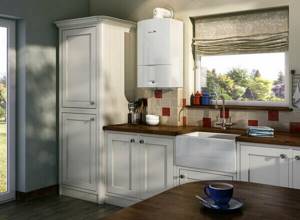
Power
Power determines the performance of the device and shows how much water it can heat in a minute . When assessing the power of a particular model, it is worth taking into account the number of people living in the apartment and how many of them will use hot water at the same time.
One tap flows about 6-7 liters of water per minute . After multiplying this parameter by the number of mixers, the result can be calculated. Manufacturers indicate power in the documentation for the equipment.
Based on power, speakers are divided into the following types:
- Minimum power 17-20 kW . Devices with such characteristics are enough to supply water to one point, since their productivity is 9-10 liters per minute. The best option for 1-2 people. The only drawback is that it will be problematic to shower and wash dishes at the same time.
- Average power 20-26 kW . The unit is capable of heating from 15 to 20 liters of water per minute. Suitable for 2-3 water intake points. The most popular option.
- High power from 26 kW . The equipment is intended for installation in private homes and is designed for large families.
Tools and materials
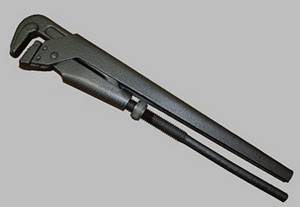
During installation you will need the following:
- Impact drill or hammer drill with a drill bit for working on concrete.
- Open-end wrenches, sizes 27/30 and 32/36.
- Gas (pipe) wrench.
- Unipack sealant.
- Sealant for pipe connections - tow, plumbing flax or FUM tape.
In addition to the water heater you will need to purchase:
- A rosette is a decorative detail through which the entry point of a galvanized pipe into a wall chimney is formed.
- An oblique filter (mud filter) for purifying water from large mechanical impurities.
- Optional: water softening system that prevents the column heat exchanger from becoming clogged with scale. For this purpose, you can use a cartridge with ion exchange resin or a hydromagnetic system.
- Pipeline parts (bends and tees), fittings, hoses and shut-off valves - for connecting the column to the water supply. Please note: it is easier to connect hoses (flexible lines), since the connection does not need to be additionally sealed (gaskets are mounted in the threaded ends).
- A gas hose through which the dispenser is connected to the gas distribution network. It must have a sufficient length and a connecting thread that matches the thread on the gas pipe of the column. If the hose tip does not fit the column nozzle, you will need to additionally purchase an adapter.
- A galvanized steel pipe with a wall thickness of 1 mm - used to connect the device to the chimney. The requirements for wall thickness are determined by the high temperature of the exhaust gases - a thin-walled part will quickly burn out. Many models have such a pipe included.
If you had to buy it yourself, pay attention to the cross-sectional dimensions: their values, as well as the required dimensions of the chimney, must be indicated in the column passport; If there are no special instructions, use the dimensions of the smoke outlet pipe as a guide.
The minimum permissible length of this pipe depends on the ceiling height:
- from 2.0 to 2.7 m: 50 cm;
- over 2.7 m: 25 cm.
Gas hoses from a reliable manufacturer are available for retail sale with a certificate - don’t be lazy and ask to see it.
Device performance
Productivity is measured in liters per minute and is indicated in the device passport . The required productivity can be determined taking into account the number of mixers. One tap flows 6-7 liters per minute.
If you need a dispenser for an apartment with two mixers, then the capacity should be 13 liters per minute . Using the table above, you can determine the required equipment performance.
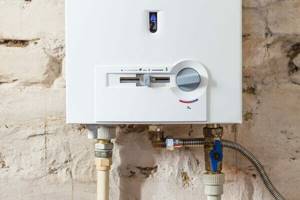
Maximum heating temperature
To increase the volume of hot water with low consumption of reserves from the boiler, you should choose a column with water heating to 75-80°C . For example: 100 liters of water from a tank at a temperature of 60°C when mixed with a cold one of 15°C will give 180 liters of 40°C.
If the water temperature in the boiler is 80°C, then with 100 liters you can get 260 liters of warm water.
Tank inner lining
The durability of the equipment depends on the quality of the material:
- steel is an inexpensive and reliable material that is resistant to corrosion and high temperatures;
- copper - has similar properties, but has a higher heat transfer, which allows you to obtain maximum heat during fuel combustion.
Types of ignition
Speakers come into action in different ways:
- manual ignition - the flame appears after turning the knob to supply gas and placing a match in this area;
- button - the unit is equipped with a button, when pressed, fuel is supplied;
- electric ignition - connecting the unit using an electrical network;
- electronic control - hot water is supplied automatically when the tap is turned on;
- battery-powered electric ignition is an electronically controlled system where you can monitor the charge level on the LCD display.
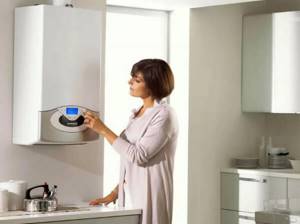
Removal of combustion products
Depending on the type of carbon monoxide output, the columns are of the following types::
- with a chimney - the classic option, when spent fuel exits through the roof;
- without a chimney - a hole is made in the wall through which carbon monoxide is removed using forced ventilation.
Removing the old column

We remove the old water heater like this:
- Turn off the valve on the gas supply line to the device.
- Using a wrench, unscrew the nut through which the gas hose is connected to the corresponding branch pipe of the column.
- If gas is supplied through a hose, the latter must be inspected after disconnection. If excessive wear is detected, this element is replaced with a new one.
- Before disconnecting the column from the water supply, you must turn off the shut-off valve. If there is none, you have to close the root valve, turning off the water in the entire apartment. Water pipes or flexible connections can also be disconnected using a wrench.
- All that remains is to disconnect the pipe leading to the chimney from the smoke exhaust pipe - and the device can be removed from the wall.
In rare cases, the gas supply line to the column is made of a steel pipe. The coupling connecting it and the pipe of the device is difficult to remove due to the layer of paint on it.
Excessive force can damage the pipe, so it is best to remove the paint with solvent first. After this, the coupling is carefully unscrewed from the column pipe, while the pipe must be held with an adjustable wrench to avoid damage.
Popular manufacturers and their descriptions
The manufacturer is one of the important points that buyers pay attention to when choosing gas equipment.
Most of them pay attention to products from trusted brands, since their units are reliable and have a long service life.
Popular brands:
- Zanussi . A well-known Italian manufacturer that has proven itself well. The range includes classic units and models with additional functionality.
- Electrolux . A Swedish company that produces devices of the highest quality and sells them at an average cost. The speakers are made of reliable materials. Due to copper heat exchangers, corrosion processes are excluded.
- Bosch . The German concern is constantly improving. All products are high quality and reliable. The models are equipped with power regulators, allowing you to set the desired water temperature.
- Ariston . Products from the Italian company are sold at affordable prices. There are devices with mechanical and electronic control types. The products are made from reliable materials that guarantee a long service life.

DIY boiler
To assemble a boiler with your own hands, you need to understand that you are taking on great responsibility as this process is unsafe. First, you will need a diagram in which each stage will be described in detail, then you need to calculate and prepare all the necessary parts for manufacturing.
IMPORTANT! The gas service does not approve of the installation of homemade equipment as it is contrary to the law.
From the geyser
A gas boiler can be made from a gas water heater. With its help you can heat a small room, such as a bathhouse. The column has high productivity, so it consumes a lot of natural gas. For this equipment, you will need to reduce the consumption of this substance by installing 2 gas burners made in China, making a hole in the nozzles measuring 1 mm. Instead of an expansion tank, a plastic tank or gas cylinder is often used. It is installed on the supply line so that no vacuum is created during pump operation. The pump is used new or taken from an old washing machine, the control unit is installed without a timer.
From a gas stove
A metal tank filled with water is installed on the heating burner, which is connected to a pipeline made of plastic through the top. A pump is connected to the container below, with the help of which water is supplied to the batteries.
To make the device safe, an expansion tank is installed; a small gas cylinder is suitable for this. A safety valve is also installed to prevent all sorts of obstacles to the supply of electricity to it.
Such heating equipment will not have enough power to heat an apartment or house during frosts, but it is well suited for heating in the autumn or spring.
Rating of the TOP 5 best models
| Place | Name | Price |
| TOP 5 best geysers | ||
| 1 | Zanussi GWH 10 Fonte | 7 000 ₽ |
| 2 | Electrolux GWH 11 PRO Inverter | 13 000 ₽ |
| 3 | Bosch WR 10-2P23 | 12 000 ₽ |
| 4 | Zanussi GWH 10 Fonte Turbo | 7 000 ₽ |
| 5 | Ariston FAST EVO ONT C 11 NG RU | 11 000 ₽ |
Dangers arising when using the column as a boiler
Before you decide to create heating using a gas water heater, you need to be prepared for possible emergency situations:
- When there is a power outage, the pump stops and the column may fail. In some cases, this even leads to the device exploding.
- If the gas pressure drops, the valve is unlikely to operate.
- If the water pressure in the system decreases, the device will not be able to turn off due to the lack of an appropriate sensor.
The best geysers
To simplify the choice of equipment, it is worth studying in detail the characteristics of popular models. The rating includes five geysers from different manufacturers that are especially popular. Pros and cons according to consumer reviews will allow you to make the right choice.
Zanussi GWH 10 Fonte
With a reliable gas heater from Zanussi, running out of hot water will no longer be a problem . The device is equipped with a high-quality heat exchanger that is safe for human health.
The burner is made of stainless steel, which is highly wear-resistant during frequent and long-term use.
Characteristics:
- productivity - 10 l/min;
- inlet pressure - 0.15-8 atm.;
- power - 20 kW;
- chimney diameter - 11 cm;
- control - mechanical;
- dimensions - 33x55x18.9 cm;
- weight - 8.2 kg.
Advantages:
- battery operation;
- power and charge indication;
- protective shutdown;
- stylish design;
- convenient installation;
- low price;
- inexpensive consumables.
Flaws:
- rapid wear of batteries;
- rustling of radiator fins.
Electrolux GWH 11 PRO Inverter
Popular model with electronic control . The flame is adjusted automatically based on the volume of water. The model is equipped with a display that displays water temperature, battery charge level and other parameters.
The heat exchanger is made of copper and does not contain foreign impurities.
Characteristics:
- productivity - 11 l/min;
- inlet pressure - 0.15-7.89 atm.;
- power - 22 kW;
- chimney diameter - 11 cm;
- control - electronic;
- dimensions - 33x55x19 cm;
- weight - 8.55 kg.
Advantages:
- automatic temperature control;
- optimal dimensions;
- Beautiful design;
- safe use.
Flaws:
- tension sensitivity;
- low quality components.
Bosch WR 10-2P23
Economical column with a chimney, equipped with a copper heat exchanger . The material is heat-resistant and provides maximum results when using gas.
The body is made of stainless steel, resistant to corrosion.
High power provides heating of up to 10 liters of water per minute. The unit supplies water to several faucets.
Characteristics:
- productivity - 10 l/min;
- inlet pressure - 0.1-12 atm.;
- power - 17.4 kW;
- chimney diameter - 11 cm;
- control - mechanical;
- dimensions - 31x58x22 cm;
- weight - 11 kg.
Advantages:
- Beautiful design;
- simple settings;
- convenient operation;
- quiet operation;
- temperature maintenance;
- Excellent performance at low pressure.
Flaws:
- one hose included;
- you need to buy a hot water supply.
Zanussi GWH 10 Fonte Turbo
Practical model made of high quality stainless steel . Pure copper heat exchanger ensures maximum natural gas performance.
Due to the simple and intuitive control system, you can easily understand how to use the device.
Characteristics:
- productivity - 10 l/min;
- power - 20 kW;
- chimney diameter - 6 cm;
- control - mechanical;
- dimensions - 33x55x19 cm;
- weight - 10.4 kg.
Advantages:
- Beautiful design;
- presence of a display;
- smooth settings;
- built-in ignition;
- high quality heat exchanger.
Flaws:
- noisy work;
- small guarantee.
Ariston FAST EVO ONT C 11 NG RU
Convenient device for daily use . Due to its high power, it can heat up to 11 liters per minute, providing hot water to all family members.
Equipped with a battery-powered electronic ignition.
Thanks to the thermostatic module, the temperature is maintained even at low pressure.
Characteristics:
- productivity - 11 l/min;
- power - 19 kW;
- inlet pressure - 0.1-10 atm.;
- chimney diameter - 11 cm;
- control - mechanical;
- dimensions - 31x58x21 cm;
- weight - 8.9 kg.
Advantages:
- simple settings;
- temperature on display;
- good work with low water pressure;
- quiet work.
Flaws:
- long-term stabilization of water temperature;
- Frequent battery replacement.
Design tips for a kitchen with a gas boiler
A gas heater reduces the already small usable area, so you need to especially carefully consider the functionality of this room.
Finishing requirements
The presence of a column also limits the number of finishing options. Here's what you need to consider when thinking through the interior.
- When decorating walls, it is better to abandon the idea of plastic panels - at least in the area where the heater is located. Constant exposure to high temperatures can cause them to melt and deteriorate. The best choice in this case is ceramic tiles or paint.
- You can install a suspended ceiling if the height of the room, taking into account the finished structure, is at least 2.2 m.
Masking pipes
City services also have certain requirements for gas pipes: they must be made of steel, in no case - corrugated; covering the pipe with plastic or drywall is strictly prohibited; there must be free access to the pipe, so a blind box is prohibited.
The simplest solution to this situation is to simply leave the pipes open. If you still want to hide communications, then you can cover them, for example, with a light, removable apron. Important: complete camouflage of pipes is already becoming an illegal layout!
You can make gas communications more invisible by painting them to match the finish or the color of contrasting elements (for example, parts of the apron) - the pipes will visually merge with the wall. It is not forbidden to use a removable box, but it should be such that it can be easily removed at any time. Finally, any unwanted items can be hidden behind kitchen cabinets or shelves. The main thing is that there is always free access to the pipe.
- Material prepared by: Anastasia Stepanova
Installation of a factory gas water heater
You should not try to make the device yourself, because the device of a gas water heater includes at least three degrees of protection:
Thanks to this, accidents are simply impossible if the equipment is connected correctly. All valves are constructed in such a way that if a break occurs, the circuit is closed. How to make a gas water heater yourself that would meet all the requirements? This can only be done by a master who has the necessary spare parts on hand. We hope that readers have given up the idea of making their own gas water heater. The exception would be families that are really tight on money. Do not forget that hoses should not be afraid of fire!
With that, we say goodbye until next time. Many issues with gas are not so obvious to ordinary people; we will reveal them as far as possible.
Source
Specifics of gas supply installation
The pipes in the apartment are the property of its owner, but unauthorized changes to the gas supply system cannot be made. For any changes, you must obtain permission from the gas service, otherwise a fine will be issued.
If the gas water heater has already been installed in this place, then this will not cause significant changes to the project. It is enough to turn off the gas valve on the pipe and replace it. If you are installing a water heater for the first time, you will need to do some wiring.
The diagram shows how to properly route gas and water pipes. Depending on the material of the pipes, you will need tools for welding metal or soldering plastic (+)
When installing pipes yourself, you must follow the following rules:
- Turn off the gas before starting work.
- Carry out work with an open window.
- Remove debris from pipes that may have arisen during installation.
- Do not route pipes through door and window openings.
- Do not use the ventilation shaft for laying pipes.
- Do not install the gas pipeline into the wall.
- Do not use flexible hoses longer than 3 meters.
- Paint metal pipes.
Particular attention should be paid to sealing the connecting elements of the gas pipeline. To do this you need to use a sealant and sealant.
After completing the wiring, you can begin installing the device.
When heaters are not allowed to be installed in an apartment or house
- If you live in a one-room apartment where the living room and kitchen are combined. The kitchen should be a separate room.
- If you want to install a gas heater in a living room, bathroom or on a loggia/balcony.
- If there is a blank door under the kitchen door, there is no ventilation slot.
- If the length of the water and especially gas hoses is more than 2.5 m.
- If a gas stove or other source of open fire is almost adjacent to the boiler.
- If you plan to hang the heater on a wall adjacent to the living room.
How to create autonomous heating in the kitchen, video:
Boilers and water heaters allow you not to depend on the whims and standards of warm water suppliers and provide a comfortable, normal water temperature at any time of the year. Although the requirements for their installation may seem too strict, this is done for the safety of residents. It is better to immediately install the equipment correctly and according to the standards than to pay later for its removal and reconnection of gas. What filters are needed for water purification in a private home can be found here.


